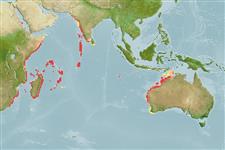>
Eupercaria/misc (Various families in series Eupercaria) >
Labridae (Wrasses) > Corinae
Etymology: Halichoeres: Greek, als, alis = salt + Greek, choiros = pig (Ref. 45335).
More on authors: Randall & Smith.
Environment: milieu / climate zone / depth range / distribution range
Ecologia
marino associati a barriera corallina; distribuzione batimetrica 15 - 56 m (Ref. 9710). Tropical
Western Indian Ocean: Sodwana Bay, South Africa (Ref. 11228), Maldives and Mauritius.
Size / Peso / Age
Maturity: Lm ? range ? - ? cm
Max length : 9.5 cm TL maschio/sesso non determinato; (Ref. 90102)
Short description
Chiavi di identificazione | Morfologia | Morfometria
Spine dorsali (totale) : 21; Raggi dorsali molli (totale) : 12; Spine anali: 15; Raggi anali molli: 12. Almost white with some black spots or lines on the head (Ref. 48636).
Found on sandy areas of deep lagoon and seaward reefs (Ref. 9710), usually along deep drop-offs with large caves, rich with invertebrate growth in depths over 20 m. Occurs in small groups of females, usually a male swimming nearby (Ref. 48636). May be found solitary (Ref. 90102).
Life cycle and mating behavior
Maturities | Riproduzione | Spawnings | Egg(s) | Fecundities | Larve
Distinct pairing during breeding (Ref. 205).
Lieske, E. and R. Myers, 1994. Collins Pocket Guide. Coral reef fishes. Indo-Pacific & Caribbean including the Red Sea. Haper Collins Publishers, 400 p. (Ref. 9710)
IUCN Red List Status (Ref. 130435)
Threat to humans
Harmless
Human uses
Strumenti
Special reports
Download XML
Fonti Internet
Estimates based on models
Preferred temperature (Ref.
123201): 22.8 - 28.4, mean 26.8 °C (based on 92 cells).
Phylogenetic diversity index (Ref.
82804): PD
50 = 0.5000 [Uniqueness, from 0.5 = low to 2.0 = high].
Bayesian length-weight: a=0.00955 (0.00451 - 0.02020), b=3.09 (2.92 - 3.26), in cm total length, based on LWR estimates for this Genus-body shape (Ref.
93245).
Trophic level (Ref.
69278): 3.3 ±0.5 se; based on size and trophs of closest relatives
Resilienza (Ref.
120179): Alto, tempo minimo di raddoppiamento della popolazione meno di 15 mesi (Preliminary K or Fecundity.).
Fishing Vulnerability (Ref.
59153): Low vulnerability (10 of 100).
Nutrients (Ref.
124155): Calcium = 116 [68, 210] mg/100g; Iron = 0.852 [0.491, 1.596] mg/100g; Protein = 18.3 [15.5, 20.5] %; Omega3 = 0.179 [0.108, 0.290] g/100g; Selenium = 26.1 [14.7, 47.9] μg/100g; VitaminA = 158 [48, 610] μg/100g; Zinc = 2.02 [1.35, 3.19] mg/100g (wet weight);
